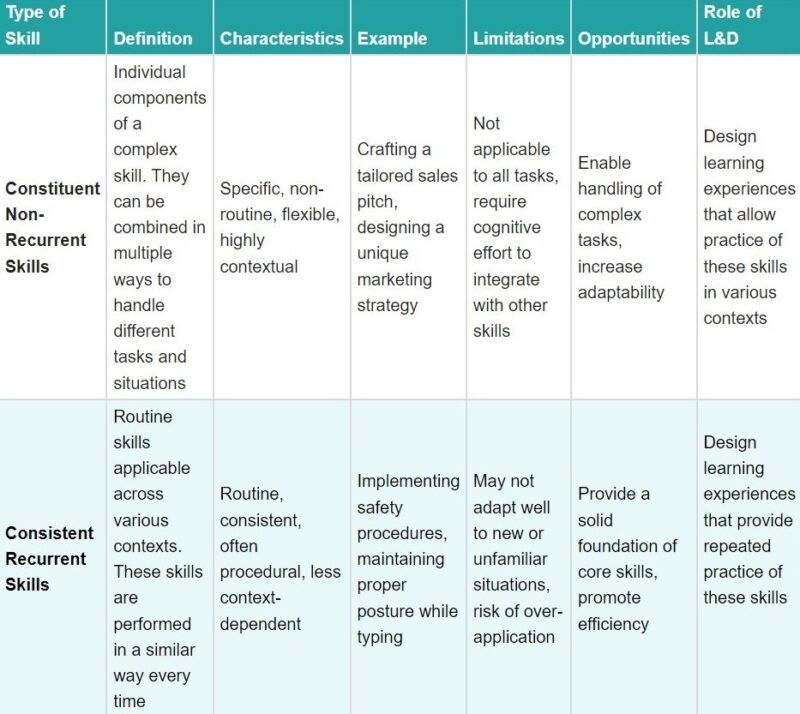AI-Driven Skills Or Competency Development?
Welcome back to the fourth part (find part 3 here) of our ongoing exploration of the transformative role of Artificial Intelligence (AI) in Learning and Development (L&D). As we journey forward, we're reminded of Steve Jobs' compelling metaphor, where he likened computers to a "bicycle for our minds", amplifying our abilities in unprecedented ways. This metaphor elegantly extends to AI in L&D, and in this fourth installment, we shift gears to focus on the fascinating concept of competency/skills development.
Competencies Versus Skills
In today's dynamic global environment, businesses are continually grappling with complex challenges and the crucial task of assembling the right team—what Jim Collins famously referred to as getting "the right people on the bus" (2001). This endeavor necessitates a profound understanding of two core concepts: skills and competencies.
Skills are specific abilities an individual possesses, often task-oriented and attainable through training, education, and practice (Rothwell, 2015). These can be bifurcated into categories like technical skills (such as coding and data analysis), and soft skills (like communication and leadership).
Competencies, conversely, are a broader concept. They amalgamate skills, knowledge, behaviors, and attitudes to enable individuals to excel in a specific role or job. Competencies are tied to organizational goals and embrace problem-solving, adaptability, and teamwork, among others. They represent not just the possession of skills, but also the capability to apply these skills in different practical scenarios (Škrinjarić, 2022). Table 1 is a comparative table to encapsulate the differences between skills and competencies.

Table 1: Skills and competencies
Understanding Constituent Nonrecurrent And Recurrent Skills
Traditional pedagogical approaches have frequently focused on individual skill development, segmenting learning into distinct units. This approach neglects the interconnected nature of skills in real-world application. Merriënboer and Kirschner (2018), in their book Ten Steps to Complex Learning, introduce us to a broader perspective of skill development—one that goes beyond the binary debate of "skills versus competencies." They present the concepts of constituent nonrecurrent and recurrent skills, which together form a more comprehensive view of skill development in a real-world context.
Constituent Nonrecurrent Skills
These are unique components of a complex skill that can be combined in various ways to handle different tasks and situations (Merriënboer and Kirschner, 2018). These skills are highly contextual and demand cognitive effort to integrate with other skills. They are not routinely required, but become crucial in certain scenarios. For example, in a crisis management situation, a leader's ability to quickly assess the situation, adapt their communication, and make effective decisions are constituent nonrecurrent skills—they vary with each unique crisis.
Constituent Recurrent Skills
These are routine skills that are applicable across various contexts and are performed in a similar way each time (Merriënboer and Kirschner, 2018). For instance, in a customer service role, the ability to empathize with a customer, follow the company's service protocol, and use customer relationship management (CRM) software are examples of recurrent skills—they are applied consistently across multiple customer interactions.
In Table 2, we provide a comprehensive overview of these concepts, highlighting the role of Learning and Development.

Table 2: Constituent nonrecurrent and recurrent skills.
Beyond Skills Vs. Competencies: A Purpose-Driven L&D Approach
One might wonder how this new perspective fits into the ongoing "skills versus competencies" debate. Interestingly, it provides a way to bridge this gap. Instead of viewing skills and competencies as separate entities, the Ten Steps model allows us to see them as interconnected components of holistic learning experiences.
In the Ten Steps approach, skill development does not happen in isolation but is intertwined with the broader context of performance (Merriënboer and Kirschner, 2018). It acknowledges that employees need to be competent—they need to combine their skills, knowledge, attitudes, and behaviors to effectively perform their jobs. At the same time, it also recognizes the diverse nature of skills: some skills need to be applied consistently (recurrent skills), while others need to be adapted to unique situations (nonrecurrent skills).
As L&D professionals, our ultimate goal is to facilitate meaningful learning experiences that help employees perform effectively in their jobs. The "skills versus competencies" debate, while providing useful insights, falls short of addressing the complexities of real-world job performance.
By adopting an approach like Ten Steps to Complex Learning, we can design evidence-informed learning solutions that address the full spectrum of skill development, from the consistent application of recurrent skills to the adaptable application of nonrecurrent skills (Merriënboer and Kirschner, 2018). In doing so, we move beyond the narrow confines of "skills versus competencies" and take a more purpose-driven approach that truly caters to the complexities of corporate learning.
Leveraging AI-Personal Assistants To Develop Constituent Nonrecurrent And Recurrent Skills
The advent of Artificial Intelligence and Machine Learning has opened a world of possibilities in the Learning and Development sector. AI-driven personal assistants are revolutionizing the way we approach skill development, particularly in relation to the constituent nonrecurrent and recurrent skills posited by Merriënboer and Kirschner (2018).
AI-Personal Assistants For Recurrent Skills Development
AI-driven personal assistants have shown great potential in helping learners develop recurrent skills. Take the example of customer service roles. The recurrent skills involved—such as empathizing with customers or using customer relationship management (CRM) software—can be developed through adaptive learning solutions delivered by AI assistants. These assistants can identify gaps in learners' understanding and deliver personalized learning materials to address these gaps.
An AI-driven personal assistant can also simulate customer interactions, allowing learners to practice and refine their recurrent skills in a risk-free environment. Through repeated exposure and feedback, learners can steadily enhance their ability to empathize and manage customer relationships effectively (Elias, 2019).
AI-Personal Assistants For Nonrecurrent Skills
Imagine a scenario where the sales team is faced with a sudden shift in market trends due to unforeseen circumstances, such as a new competitor's entry or a sudden economic downturn. Each of these situations presents unique challenges and requires different strategic approaches. To prepare the sales team for such scenarios, the AI assistant generates a variety of complex market situations. These simulations require the team to analyze the changing market landscape, reassess their sales strategy, and make key decisions in response to the shifting trends.
For example, in the face of a sudden economic downturn, the team might need to revise their sales targets, prioritize certain product lines, or adapt their sales pitches to address the customers' newfound price sensitivities. On the other hand, a new competitor's entry might require the team to differentiate their products more clearly, adjust their pricing, or increase their marketing efforts.
By dealing with these high-stakes, variable scenarios, the team practices their domain-specific strategic thinking, decision-making, and problem-solving skills. These complex, nonrecurrent skills allow them to adapt to ever-changing real-world situations, making them more effective and resilient in their roles.
Conclusion
The discussions around skills versus competencies often shed light on the complexities that permeate the Learning and Development landscape. To enhance the relevance and effectiveness of L&D, we must move beyond binary discussions of skills versus competencies. The Ten Steps to Complex Learning model doesn't diminish the discussion about skills and competencies; rather, it takes it a step further, integrating a more holistic, realistic view of what it takes to perform effectively in the world of work.
Up Next: Unpacking L&D's Role In The AI Era
As we reach the end of our exploration of AI’s potential to support constituent nonrecurrent and recurrent skills, an intriguing question arises—how does AI intersect with the contemporary reality of designing learning experiences?
Hold on to that curiosity as we step into the next article of our series. We will be diving into the compelling world of AI driven design of learning experiences, with AI as our steadfast ally. What role does AI play in transforming learning into an integral part of our work routine? How can L&D professionals supercharge their services with AI?
As you continue exploring the fascinating world of AI and its potential to revolutionize Learning and Development, we invite you to delve deeper with us. Visit our website Partners in AI for more in-depth information and insights, and the opportunities that AI brings to the corporate learning sphere.
This article series titled "Is AI The Bicycle Of The Mind?" serves as a prelude to my upcoming book, Value-Based Learning, offering a sneak peek into the insightful content that the book will feature. Please note that all rights to the content in these articles and the upcoming book are reserved. Unauthorized use, reproduction, or distribution of this material without explicit permission is strictly prohibited. For more information and updates about the book, please visit: Value-Based Learning.
The author of this work holds intellectual property rights, and this content cannot be reproduced or repurposed without express written permission.
References:
- Clark, R. C., and R. E. Mayer. 2016. E-learning and the science of instruction: Proven guidelines for consumers and designers of multimedia learning. Hoboken, NJ: John Wiley & Sons.
- Collins, J. 2001. Good to Great: Why Some Companies Make the Leap...and Others Don't. New York: Harper Business.
- Merriënboer, J., and P. Kirschner. 2018. Ten Steps to Complex Learning. A Systematic Approach to Four-Component Instructional Design. New York/London: Routledge.
- Neelen, M., and P. Kirschner. 2020. Evidence-Informed Learning Design: Creating Training to Improve Performance. London: Kogan Page Publishers.
- Noe, R. A., A. D. Clarke, and H. J. Klein. 2014. "Learning in the twenty-first-century workplace." Annual Review of Organizational Psychology and Organizational Behavior 1: 245-75.
- Rothwell, W. J. 2015. Competency-Based Training Basics. Alexandria, VA: American Society for Training and Development (ASTD) Press.
- Škrinjarić, B. 2022. "Competence-based approaches in organizational and individual context." Humanities and Social Sciences Communications 9, article no. 28.
- Zawacki-Richter, O., V. I. Marín, M. Bond, et al. "Systematic review of research on artificial intelligence applications in higher education – where are the educators?" International Journal of Educational Technology in Higher Education 16 (1):1-27.
Image Credits:
- The tables within the body of the article were created/supplied by the author.









